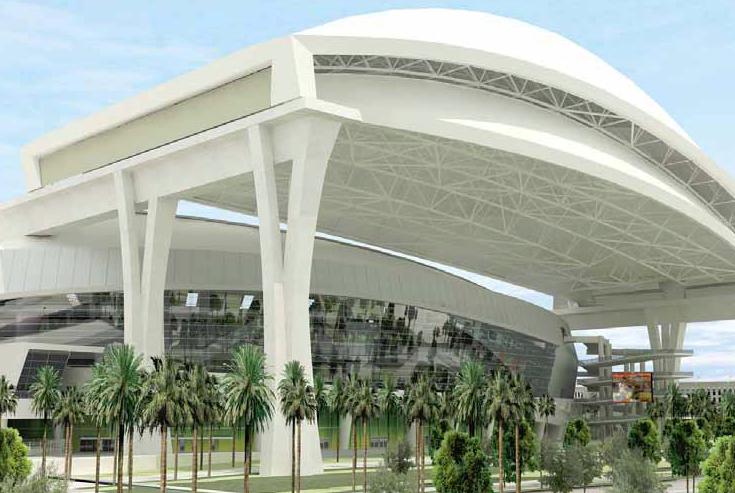
Hunt Construction Group brings extensive ballpark and stadium-building experience to the joint venture formed to oversee construction of the Florida Marlins’ new Major League Baseball stadium. Keith Regan learns how project leaders are using technology and teamwork to ensure the team can play ball in the spring of 2012.
Over the past 66 years, Hunt Construction Group has gained experience bringing a variety of building projects to fruition. From casinos and correctional facilities to corporate offices and performing arts centers, Hunt’s experience is broad and varied. Among the specialties of the 675-employee firm—which ranks as the 26th-largest contractor in the country with $2.14 billion in annual revenue, according to Engineering News-Record—is building ballparks.
In fact, Hunt ranks as the number one contractor in the sports facilities field, with projects in its portfolio that include AT&T Park in San Francisco, Busch Stadium in St. Louis and Citizens Bank Ballpark in Philadelphia, along with stadiums for the National Football League and college teams. Hunt has helped build some 60 stadium projects since 1980.
That experience is now being leveraged to help get the new Florida Marlins ballpark built in time for opening day of the 2012 Major League Baseball season. Even before bidding to win the role of construction manager on the $515 million project, Hunt forged a joint venture with Moss & Associates.
“We always try to find a local partner in a city that knows the local flavor of the community, the best subs to seek bids from and the like,” says Pat Delano, construction manager with Hunt. “Whether it’s knowing the landscape or dealing with the different municipalities and jurisdictions, it’s always good to have someone with local knowledge. And in this case we found a partner that has the same philosophy, culture and mentality as our company.”
Hunt not only brought stadium-building experience but also a past relationship with architects Populous Inc.—formerly known as HOK Sports. That has helped form the nucleus of what has become a strong team that works extremely well together, according to Delano.
That teamwork has been especially important because the Marlins project is almost two projects in one, he adds. The ballpark will feature a retractable roof—designed to make it possible for games to be played through the monsoon-like rains that often come up out of nowhere on summer afternoons in southern Florida—and the supports and structure for that roof are actually being built and installed first. Now that this work is complete, Hunt can concentrate on the ballpark structure.
“We basically have two critical paths that we’re following at once,” Delano says. “We’re going to be building the ballpark now that the retractable beams are up in the air, so sequencing to keep it all on schedule is critical. We’re constantly going over the schedule with the project owners and other representatives to ensure everyone’s on the same page as we go forward.”
Technology helps keep things running smoothly, with three-dimensional building information modeling (BIM) systems used to design the project from start to finish. With a scheduling program overlaid, the team can see the project as it will come together in the field and can spot conflicts and issues before they actually arise on the ground. “It helps minimize what has to be re-fabricated and redone, and that obviously helps with the scheduling aspect as well as with the budget.”
In addition to embracing technology, the joint venture partners also share the same philosophy on safety and recently earned a South Florida Sunshine Safety Award from the University of South Florida. “It was great to get that early in the project, and it gives us a high standard to live up to for the rest of the work,” says Delano.
When finished, the new ballpark—yet to be formally named—will feature 37,000 seats, making it one of the smaller ballparks in the league, including 50 suites, six of which will be set aside as party suites for daily rental. The west side of the stadium will feature a concourse area with restaurants and other amenities, and when opened, the roof will retract over that plaza to create shade from the subtropical sun. In addition to the three-panel retractable roof, the stadium will feature a sliding glass offering stunning views of the Miami skyline.
The ballpark, which is going up on the site of the former Orange Bowl, will also feature a Marlins home run feature in the centerfield bleachers area and will be almost surrounded by parking garages—construction of which will begin before the ballpark is completed.
The project is striving for Silver certification from the US Green Building Council’s LEED program. “The design team has submitted to USGBC, and we’ll do our part as the construction team,” says Delano.ÔÇ¿
The construction team remains confident it can meet its schedule and have the Marlins playing on their new diamond in 2012. “Right now if you go to a game, you can expect it to be very hot and you can expect a rain delay,” Delano says, noting that the retractable roof will enable the park to be air conditioned against the scorching heat.
In the meantime, work continues to move forward on a number of fronts, and when issues arise, all the team has to do is ask around to find the right answer. “Among all the people on the team, we probably have experience on about 50 different stadium projects,” Delano notes. “Chances are that someone here has already encountered whatever situation we might run into along the way.” http://www.huntconstructiongroup.com













